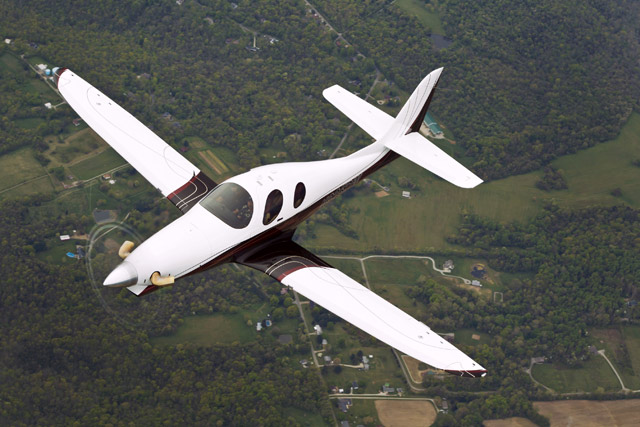Sleek single-engine turboprop offers serious performance
Ever wonder what happens when you hang a 750-shaft-horsepower turboprop engine on a four-seat single that weighs 4,550 pounds? Stellar performance is a given. Add to that an eye-pleasing carbon-fiber airframe, and pilots’ jaws tend to drop in the presence of Lancair’s Evolution.
The Evolution—with flowing curves and bubble-shape windows—oozes modernity. And with performance and efficiency to match its looks, the Evolution should be a slam-dunk hit with buyers. Unfortunately, the Evolution is not a turn-key, FAA-certified airplane for a pilot with a high-performance sign-off and $1.5 million burning a hole in his pocket. Build time is estimated at 1,500 hours.
Lancair brings buyers to its facility for a two-week quick-start program during which factory experts supervise builders on the key structural portion of the process. After that, it’s up to the builder to complete the engine, avionics, interior, and paint. For those not willing to commit to the amateur-built route there is a (tiny) glimmer of hope. The Evolution is designed to FAR Part 23 standards and complies with the required 61-knot stall speed for single-engine turboprops. As of yet, there are no plans to certify it. But for the pilot with the time, mechanical skill, and finances, it doesn’t get much better than this pocket-size hot rod.
Pressurization provides a 7,000-foot cabin at FL280, the RVSM-limited ceiling of the Evolution. Avionics are Garmin G900X, GFC 700 autopilot, and L3 Trilogy standby EFIS. Anti-ice is via electrically heated wing, horizontal stabilizer, and propeller leading edges and TKS-fluid deice for the windshield. Lancair recently announced the availability of pneumatic deice boots as an option for the wings and tail.
Lancair also has made a BRS whole-airplane parachute system as a standard option starting with kit number 70. The system will add 80 pounds and an additional $60,000 to the base price. Like Cirrus airplanes, it will have a 10-year repack requirement. Finally, a modification to the engine inlet is claimed to recover 100 feet-pounds of torque and improve ice resistance. A heated inlet is optional and an inertial separator is standard for ice protection.
With the additional ram-air recovery, Lancair says the Evolution will more reliably be a 300-knot airplane. Earlier models had a maximum cruise of 300 KTAS in cold temperatures on about 40 gph. More typical cruise is 285 KTAS at FL280 on 35 gph. Pull back fuel flow to 25 gph and you can still get 250 KTAS. Although Lancairs are not known for prowess on short runways, the Evolution’s brute acceleration on takeoff and reverse thrust on landing allows it to utilize 2,000-foot strips. Climb rates at sea level are 3,000 to 4,000 fpm.
Lancair has sold 71 Evolution kits as of August 2015—59 of them are flying. Although you won’t be able to get a brand-new one without building one, there are used Evolutions for sale. If having just four seats fits the bill for you, the Evolution will make a speedy, modern, and efficient transport. AOPA
Pete Bedell is a pilot for a major airline and co-owner of a Cessna 172 and Beechcraft Baron D55.
SPEC SHEET
Lancair Evolution
$1.45 million completed
Powerplant | 750-shp Pratt & Whitney PT6A-135A
Length | 29 ft 5 in
Height | 8 ft 3 in
Wingspan | 37 ft
Seats | 4
Max takeoff weight | 4,550 lb
Takeoff distance over 50-ft obstacle | 1,500 ft
Max cruise speed | 300 kt
Landing distance over 50-ft obstacle | 1,500 ft
Range | 1,100 nm



